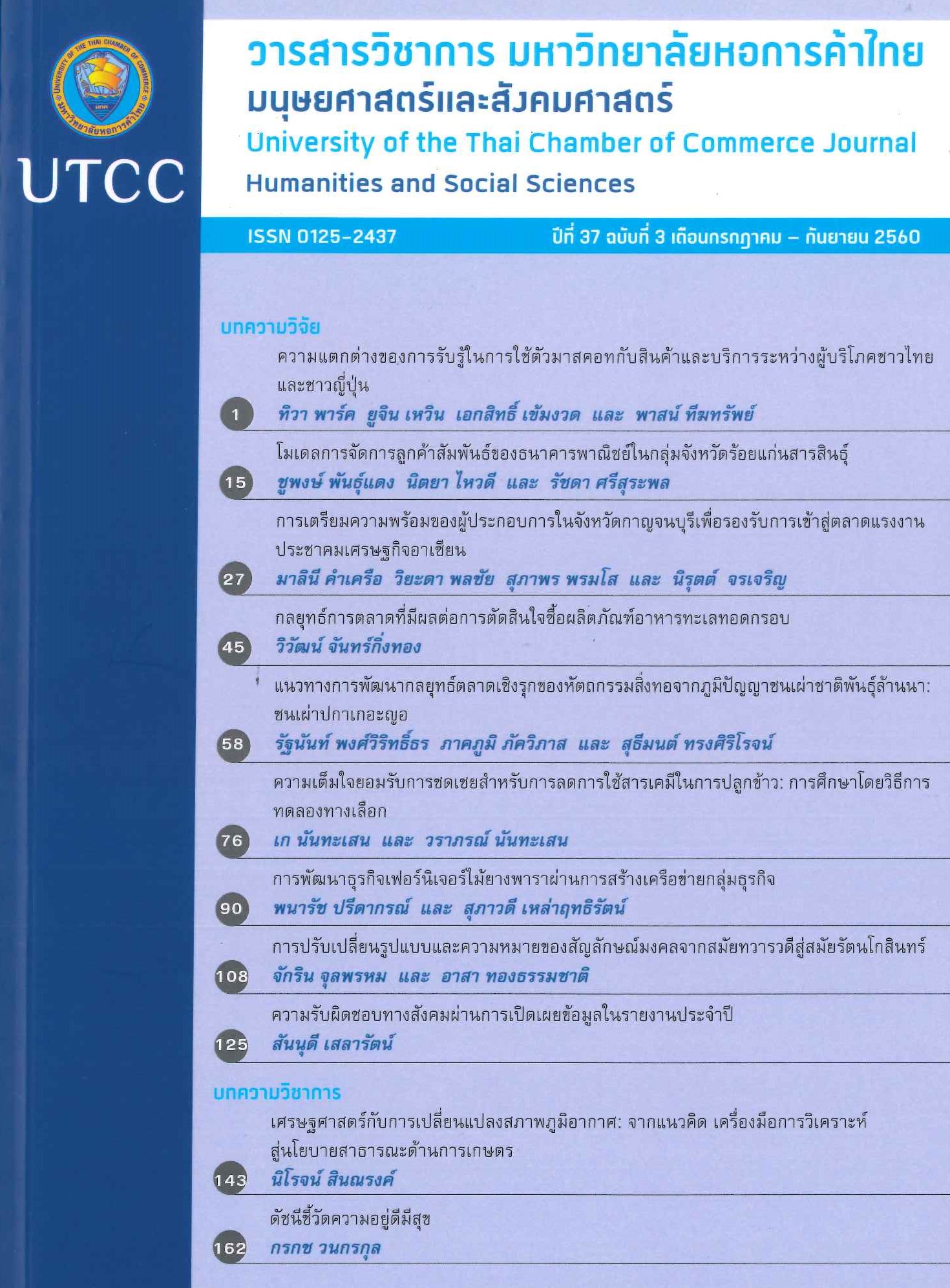The Willingness to Accept Compensations for Reduction of Chemical Usage in Rice Production: A Choice Experiment Study
Main Article Content
Abstract
This research investigates the factors influencing rice farmers’ willingness to accept compensations (WTAC) and estimates their preferences for reducing chemical usage by applying the choice experiment method (CEM) and a conditional logit model. Data were collected from 220 rice farmer households in Phrao district, Chiang Mai province. Included in the results are attribute and socio-economic factors that affect the farmers’ willingness to accept compensations. The attribute factors embrace an attribute of substituting organic fertilizers for chemical fertilizers, two attributes of substituting organic herbicides for chemical herbicides used, and two attributes
of substituting organic insecticides for chemical insecticides and a money support. Included in socio-economic factors are age of farmers, education level, farming experience, number of household labors, farm size, cost of chemical fertilizers and annual income. The empirical results relating farmers’ preferences for reducing chemical usage include that farmers will decrease 50% of chemical fertilizers used and increase 50% of organic fertilizers used if they receive 81.88 baht per Rai; they will decrease 50% of chemical herbicides used and increase 50% of organic herbicides used if they receive 69.00 baht per Rai; and they will decrease 75% of chemical insecticides used and increase 25% of organic insecticides used if they receive 95.00 baht per Rai.
Article Details
ลิขสิทธิ์ของบทความ
ผลงานที่ได้รับการตีพิมพ์ถือเป็นลิขสิทธิ์ของมหาวิทยาลัยหอการค้าไทย ห้ามมิให้นำเนื้อหา ทัศนะ หรือข้อคิดเห็นใด ๆ ของผลงานไปทำซ้ำ ดัดแปลง หรือเผยแพร่ ไม่ว่าทั้งหมดหรือบางส่วนโดยไม่ได้รับอนุญาตเป็นลายลักษณ์อักษรจากมหาวิทยาลัยหอการค้าไทยก่อน
References
Budaka, B. (2007).Economic valuation of elephant management in Thailand. (Unpublished master’s thesis). Kasetsart University. Bangkok.(in Thai).
Chaing Mai Agricultral Office. (2012). 2011/ 2012 Chiang Mai cultivated statistic. Retrieved August 10,2012, from https:// chiangmai.doae.go.th (in Thai).
Colombo, S., Hanley, N.,& Calatrava-Requena, J. (2005). Designing policy for reducing the off-farm effects of soil erosion using choice experiment. Journal of Agricultural Economics, 56(1), 81-95.
Department of Disease Control, Bureau of Epidemiology. (2011). 2010 annual report of surveillance. Chiang Mai, Thailand: Author. (in Thai).
Hanley,N.(2000). Modeling recreation demand using choice experiments: Climbing in Scotland.: University of Glasgow, Department of Economics.
Hope,R.A., Borgoyary, M.,& Agarwal, C.(2006). Incentives that work for farmers and wetlands: A case study from the Bhoj Wetland, India. London, England: Department of International Development.
Ladenburg, J., Dubgaard, A., Martinsen, L.,& Tranberg, J. (2005). Economic valuation of the visual externalities or off-shore wind farms. Copenhagen, Denmark: University of
Muller, R.A., & Diener, A.A. (1997). Economic valuation of air quality in the regional municipality of Hamilton-Wentworth. Ontario, Canada: McMaster University Hamilton, Department of Economics.
Ngamsomsuke, W., & Nunthasen, K.(2015). Value of statistical life by applying contingent valuation method: A case of chemical substance application for rice farmers in Phrao District, Chiang Mai Province. Chiang Mai, Thailand: Maejo University, Faculty of Economics. (in Thai).
Nunthasen,K.(2008). Willingness to accept of soil and water conservation measure in Upper Mae-Sa Watershed, Chiang Mai Province. (Unpublished master’s thesis). Chiang Mai University. (in Thai).
Sanglertsawai, S.(2006). Assessing consumer preferences for Doikham safe vegetable in Bangkok: A choice modeling approach. (Unpublished master’s thesis). Kasetsart
University, Bangkok. (in Thai).
Udomsak, S.(2002). An economic valuation of coastal ecosystems in Phang Nga Bay, Thailand.: National Institute of Development Administration, School of Development Economics.
Yu, L.L., & Cai, Y.Y. (2015). Ecological compensation based on farmers’ willingness: A case study of Jingsan County in Hubei Province, China. Ying Yong Sheng Tai Xue Bao, 26(1): 215-23.


